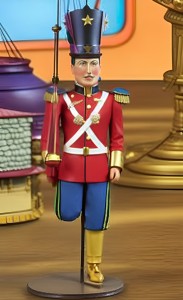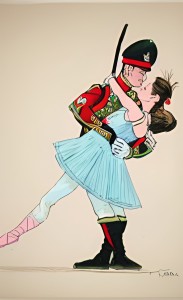History of creation
The tale was first published in 1838 in the collection “Fairy Tales Told for Children” (first issue of the second volume). It marks an important milestone in the work of Andersen: for the first time when creating a literary fairy tale, he did not work with any particular folklore or literary source, completely relying on his own imagination and literary erudition.
Literary direction and genre
A literary fairy tale with parable elements is fully sustained in the spirit of late romanticism, conscious of its “romance” and slightly teasing itself. The romantic doom of light souls, the unattainability of the ideal of high love in life and its attainability only in death – all this is served with a cold, detached, ironic exaggeration. Of course, all these nuances are intelligible to the adult reader – both modern Andersen and any other era. Specialists in developmental psychology have not yet reached a consensus on how such “Fairy Tales Told for Children” (which is exactly what the name of Andersen’s book is) affect the child’s psyche and form the life (cognitive and ethical) strategies of a young reader.
Theme and issues
The theme of the tale is the total dependence of man on the vicissitudes of fate, and the problem is the meaning of human life, human faith, loyalty and perseverance. At the same time, in a small space of a fairy-tale text, the great storyteller managed to place all the main philosophical subsections of meaning-life issues.
The plot and composition
The plot of the fairy tale flows entirely from the image of the main – romantic – hero who from birth is “not like everyone else” (all the tin soldiers on two legs, but this one-legged) and, of course, “the most remarkable of all.” The plot of the tale is the fate of the one-legged tin soldier. Does it not resemble the fate of those who are “like everyone else” – or does it only seem so to the tin soldier itself?
The fact is that a soldier comprehends all the events of his life through the prism of a high feeling – love for a dancer. Moreover, for the entire duration of the action, neither the soldier nor the dancer not only said a single word (neither to each other, nor to anyone at all), but also did not make a single movement. To the soldier himself, their toy constraint seems to be particularly steadfast, faithful to the once chosen service, and on this basis he believes in the kinship of their souls and the similarity of their destinies. What in this case seems to be a dancer – neither the soldier, nor the reader, or, apparently, the author of this story himself knows about.
The plot composition of this tale is a classic composition of a romantic short story. In the exposition we get a clear idea of the scene and the main characters. In the eyeballs, we learn about how the soldier’s feelings for a dancer are tied, and that the forces of evil (troll) are apparently going to prevent this high beautiful love. The impetus for the development of the action – “by the grace of the troll or from the draft” – is a soldier falling onto the street from a window that suddenly opened. And there, street boys put him in a paper boat; what follows is his “odyssey” – many adventures. Then, as in the plot of the ancient parable of Polycrates (popular in the first half of the 19th century in the ballad retelling of Friedrich Schiller), the fish that swallowed the tin soldier ends up in the kitchen of the previous owners. The soldier, once again set on the table, is pleased to note that his beloved, during his absence, retained the same position: “This is endurance!” But there comes an unexpected climax: “For no reason” (“Probably, the troll set it up ! ”) The boy throws a soldier into the stove. And here a draft from the open door picks up a paper dancer, “and she, like a sylph, fluttered right into the stove to the tin soldier,” but again she hardly managed to feel something, for she burned out in an instant. The denouement fit in one phrase about the next morning how a maid raked ash from a stove and found a small tin heart. From the dancer, there was only one outlet, and even that was burnt and blackened like coal.
Heroes
The story of the main characters, their tragic fate, has only external signs of romantic love, followed by a tragic denouement. The one-legged tin soldier is holy simplicity, he has one, but an ardent passion for the dancer, which seems to him to be related to him, i.e. also one-legged. However, her lover is not so simple: in fact, she has a second leg, so her one-legged is not an election (as in the case of a soldier), but only a pose.
The troll – the personification of evil – again has only external signs of magical evil power. And his threats are essentially empty. Twice a soldier – at those moments when “fate” rudely invades his life – thinks, “is this a troll trick.” However, the reader, by common sense, understands that neither the desire of adults to ventilate the room (the first fall of the soldier – into the street), nor the cruel prank of the boy (the second and last fall of the soldier – into the oven), the little toy troll did not take any, even fabulous, part.
Artistic Originality
The main characteristic of the artistic originality of this literary fairy tale is precisely its literature. For the first time dispensing with his work without a single concrete source of a fairy-tale plot, Andersen did not paradoxically reduce, but increased the dependence of understanding of the text by an adult reader on his (reader) literary erudition. Thus, it is impossible to appreciate and feel the romantic irony of a fairy tale connected with the “sea” adventures of a tin soldier without knowing the relevant passages from Homer and Herodotus. And to understand why the dancer “fluttered” to the soldier in the stove “like a sylph”, you need to know that the sylphs in Celtic and German mythology are ethereal creatures that have only the external image of a woman and personify the element of air.
At the same time, a simple personification is by no means the main artistic device in this tale. Without exception, her images are complex symbols, often ironically rethought and having a double, or even a triple bottom.

